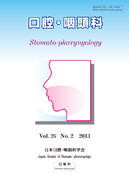Volume 26, Issue 2
Displaying 1-17 of 17 articles from this issue
- |<
- <
- 1
- >
- >|
Symposium Assessment and treatments of deep neck infection including peritonsillar abscesses
Original Article
-
2013 Volume 26 Issue 2 Pages 111-117
Published: June 10, 2013
Released on J-STAGE: August 26, 2013
Download PDF (836K)
Clinical Seminar Oral mucosal diseases
Review
-
2013 Volume 26 Issue 2 Pages 119-130
Published: June 10, 2013
Released on J-STAGE: August 26, 2013
Download PDF (8277K)
Original Article
-
2013 Volume 26 Issue 2 Pages 131-136
Published: June 10, 2013
Released on J-STAGE: August 26, 2013
Download PDF (1502K) -
2013 Volume 26 Issue 2 Pages 137-141
Published: June 10, 2013
Released on J-STAGE: August 26, 2013
Download PDF (728K) -
2013 Volume 26 Issue 2 Pages 143-148
Published: June 10, 2013
Released on J-STAGE: August 26, 2013
Download PDF (1333K) -
2013 Volume 26 Issue 2 Pages 149-154
Published: June 10, 2013
Released on J-STAGE: August 26, 2013
Download PDF (1169K) -
2013 Volume 26 Issue 2 Pages 155-160
Published: June 10, 2013
Released on J-STAGE: August 26, 2013
Download PDF (495K) -
2013 Volume 26 Issue 2 Pages 161-166
Published: June 10, 2013
Released on J-STAGE: August 26, 2013
Download PDF (410K) -
2013 Volume 26 Issue 2 Pages 167-172
Published: June 10, 2013
Released on J-STAGE: August 26, 2013
Download PDF (517K) -
2013 Volume 26 Issue 2 Pages 173-177
Published: June 10, 2013
Released on J-STAGE: August 26, 2013
Download PDF (1160K) -
2013 Volume 26 Issue 2 Pages 179-183
Published: June 10, 2013
Released on J-STAGE: August 26, 2013
Download PDF (2091K) -
2013 Volume 26 Issue 2 Pages 185-190
Published: June 10, 2013
Released on J-STAGE: August 26, 2013
Download PDF (3201K) -
2013 Volume 26 Issue 2 Pages 191-195
Published: June 10, 2013
Released on J-STAGE: August 26, 2013
Download PDF (846K) -
2013 Volume 26 Issue 2 Pages 197-201
Published: June 10, 2013
Released on J-STAGE: August 26, 2013
Download PDF (777K) -
2013 Volume 26 Issue 2 Pages 203-206
Published: June 10, 2013
Released on J-STAGE: August 26, 2013
Download PDF (388K) -
2013 Volume 26 Issue 2 Pages 207-210
Published: June 10, 2013
Released on J-STAGE: August 26, 2013
Download PDF (797K)
Technical Note
-
2013 Volume 26 Issue 2 Pages 211-216
Published: June 10, 2013
Released on J-STAGE: August 26, 2013
Download PDF (820K)
- |<
- <
- 1
- >
- >|
